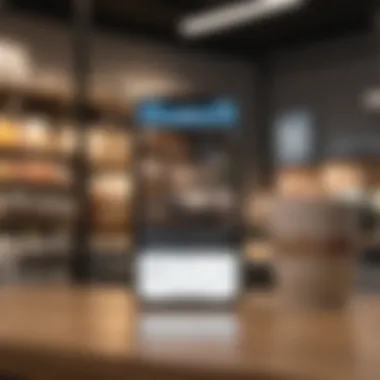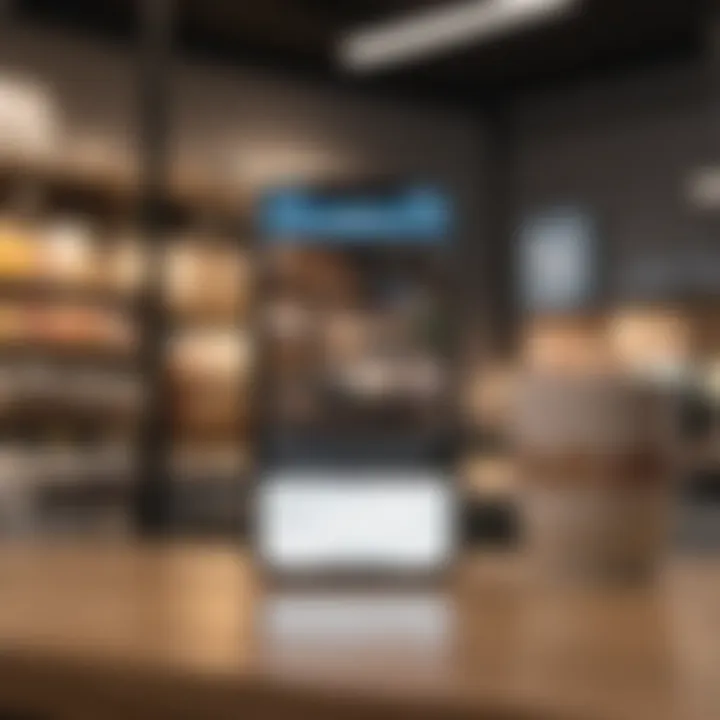Using Klarna In-Store: A Detailed Exploration


Overview of the Topic
Understanding Klarna’s in-store payment system is essential for both consumers and retailers in today’s fast-paced retail landscape. Klarna, known mainly for its online payment solutions, is gradually making waves in brick-and-mortar establishments. So why is this important? For consumers, it opens up avenues for flexibility in payment, allowing purchases to be manageable within their financial means. For retailers, it enhances the shopping experience, potentially leading to increased sales and customer loyalty.
Using Klarna in-store means tapping into a payment method that can ease the burden of immediate expenditure. The essence of this service includes a pay-later option—a reason many consumers gravitate towards it. With Klarna, shoppers can buy items and choose how and when to pay, be it immediately, within a few weeks, or even through installment options.
Key Benefits and Implications
- Flexibility: Consumers can shop without immediate payment requirements, leading to a more carefree spending experience.
- Attracting New Customers: Retailers can draw in a demographic who may not have otherwise considered purchasing due to cash flow constraints.
- Improved Sales: By offering Klarna, shops may witness a rise in average order value as customers feel empowered to purchase more.
However, it's important to consider some implications as well. Klarna’s approach nudges shoppers into a space where deferred payments can lead to overspending.
Exploring Strategies and Tips
When considering how to implement Klarna effectively for in-store purchases, several practical tips come to mind:
- Educating Staff: Ensure that employees understand how Klarna works to assist customers with questions or confusion.
- Marketing the Technology: Promotions highlighting the availability of Klarna can boost consumer interest and drive foot traffic into stores.
- Integrating with Existing Systems: Retailers should evaluate whether their current systems can comfortably accommodate Klarna's payment processing.
In terms of management, merchants need clear financial tracking strategies. Monitoring customer engagement with Klarna can provide invaluable insights for better inventory and promotional strategies.
Case Studies and Examples
One notable case is the use of Klarna by leading fashion retailers. Brands like Zara and H&M have started integrating Klarna in their stores, which has allowed them to attract a younger audience dramatically. The increase in basket size can often be attributed to the impulse buy factor Klarna generates—this highlights the importance of understanding customer behavior when deploying such payment options.
However, there are pitfalls. A store that introduced Klarna without staff training experienced customer dissatisfaction due to insufficient assistance. This led to returns and negative reviews, showing that customer experience matters as much as the payment option itself.
Comparison of Financial Products
When evaluating Klarna against other financial options like Afterpay or Affirm, certain features set them apart. Here’s a snapshot of the comparison:
| Feature | Klarna | Afterpay | Affirm | | Payment Plans| Yes (flexible) | Yes (structured) | Yes (more options) | | Credit Check | No (soft inquiry) | No (soft inquiry) | Yes (hard inquiry) | | Merchant Fees| Moderate | Higher | Moderate |
Pros and Cons
- Klarna: Flexible payment, broad acceptance.
- Afterpay: Easier to track single payments, but potentially higher fees for merchants.
- Affirm: Provides more in-depth credit options but can impact consumer credit score.
Expert Insights and Recommendations
Financial experts agree that the evolution of payment methods, including Klarna, reflects shifts in consumer habits. As shoppers desire more control over their financial decisions, integrating flexible payment options will become increasingly pivotal for retailers.
"Retailers must adapt to the changing landscape or risk losing relevance. Offering Klarna isn’t just a trend; it's a path to customer engagement and retention."
To leverage Klarna effectively, retailers should not only adopt the technology but accompany it with robust customer service and training. This ensures that consumers feel supported and confident in using the service—ultimately enriching their shopping experience.
Prelims to Klarna
In the rapidly changing world of finance, the introduction of modern payment solutions contributes significantly to consumer spending and retail strategies. Klarna, as a payment service provider, has gained a lot of traction among shoppers looking for flexibility when making purchases. Understanding the essentials of Klarna and how it operates is crucial for anyone considering its services, especially in an in-store setting.
Klarna functions as a bridge between consumers and retailers, enabling buyers to shop now and pay later, making their shopping experience smoother and often more financially manageable. This payment method can be particularly attractive in a brick-and-mortar environment where immediate transactions have previously constrained consumer spending freedom.
The importance of discussing Klarna in the context of in-store purchases lies in the growing trend of Buy Now, Pay Later (BNPL) services, which resonates well with consumer behavior today—especially among younger shoppers. These individuals often seek greater control over their spending habits, hoping to balance gratification with financial responsibility.
This guide aims to provide a thorough understanding of Klarna’s functionality, its applications in physical retail locations, and the broader implications this payment model has on consumer behavior and shopping experiences.
Understanding Klarna's Service Model
Klarna's service model is straightforward, yet it encompasses various layers that facilitate its operations. Essentially, it allows consumers to shop at a multitude of retailers without the immediate need for full payment. When making a purchase, shoppers can opt to pay in installments over a specified timeframe, typically within a few weeks or months. This model has become particularly popular due to its simplicity and accessibility.
When a consumer selects Klarna at checkout, whether online or in-store, the system takes care of the payment to the retailer, allowing them to receive the funds immediately. The shopper is then responsible for repaying Klarna, either in full or in manageable chunks spread across time. This not only eases the burden of upfront costs but also offers users flexibility, ultimately enhancing customer satisfaction.
Moreover, Klarna has integrated features that allow customers to keep track of their spending, thereby encouraging better financial habits. With a user-friendly app interface, consumers can manage their purchases and payment schedules effortlessly, fostering transparency in their spending.
The Emergence of Buy Now, Pay Later Services


The concept of Buy Now, Pay Later (BNPL) has really taken off in the last few years, transforming how people approach purchases in both digital and brick-and-mortar environments. Initially, credit cards dominated the landscape, but the drawbacks—such as high-interest rates and hidden fees—led consumers to search for more straightforward, debt-averse options.
Klarna exemplifies this shift, riding the wave of a broader trend towards consumer financial equity. Young shoppers, particularly millennials and Gen Z, are turning to BNPL services like Klarna to avoid the pitfalls of traditional credit. Through flexible payment solutions, Klarna has managed to captivate a demographic that values convenience and control.
Reports indicate that consumers utilizing BNPL services see a significant increase in total spending, especially when sampling new brands or experimenting with higher-priced items they might have otherwise avoided due to budget constraints.
"Klarna and similar BNPL providers are not just changing the way we pay; they are revolutionizing the shopping experience itself," observes financial analyst Jane Doe.
As buyers feel empowered by means of easy financing options, it becomes important for retailers to recognize the paradigm shift toward consumer-centric spending models. Understanding how Klarna and BNPL services can enhance consumer experience will help retailers improve their strategies for attracting and retaining customers.
Klarna's In-Store Functionality
Klarna's in-store functionality is making waves in the retail sector, especially as consumers lean towards more flexible payment options. With the continuous evolution of shopping preferences, Klarna provides a much-needed service that aligns with modern consumer behavior. This section aims to delineate specific aspects of using Klarna in physical stores, shedding light on its benefits, and crucial considerations.
Ways to Use Klarna Instantly
Using Klarna in-store is straightforward and enhances the overall shopping experience. When you walk into a store that accepts Klarna, there are several ways you can utilize this service:
- Klarna App: The first step is downloading the Klarna app. It acts as a digital wallet, where you can browse retailers, check products, and make purchases directly from your phone.
- Pay in Four: A popular payment option is the ability to split your total into four interest-free payments, paid every two weeks. This is particularly useful when making larger purchases, allowing you to manage cash flow without breaking the bank all at once.
- One-Time Card: For merchants that don’t have a direct Klarna integration, you can generate a virtual card in the app for your in-store purchases. This means you can shop at virtually any retailer that accepts credit cards, using Klarna’s payment flexibility.
- Scan and Pay: Some retailers enable a feature where you can scan items in store and complete your payment via the app. It's a convenient option, especially when you wish to skip the line.
With these techniques, consumers can shop with confidence, knowing they have alternatives to traditional payment methods.
Supported Retailers and Locations
Klarna continues to expand its network of retail partnerships, making it easier for consumers to leverage its in-store functionality. Here are notable retailers and locations supporting Klarna:
- Fashion Chains: Major fashion retailers such as H&M, ASOS, and Urban Outfitters allow you to shop in-store using Klarna. These are ideal for fashion-forward consumers who appreciate the flexibility of payment.
- Home Goods: Stores like Wayfair and Macy's have jumped on the bandwagon, providing customers the option to enhance their home decor while paying at their convenience.
- Electronics: Best Buy is a prominent player in electronics retail that supports Klarna. You can grab that new gadget without fretting about full payment upfront.
The geographic reach of Klarna is expanding rapidly, you can find Klarna partners in numerous locations across the United States and several countries in Europe.
Moreover, it pays to keep an eye on local retailers, as many smaller businesses are also adopting Klarna to attract more customers and provide alternative payment options.
"Klarna's in-store functionality not only enables consumers to manage their spending better but also encourages impulse purchases due to its simple payment structure."
By understanding how to use Klarna in stores and knowing which retailers accept it, shoppers can truly enhance their buying power.
Process for In-Store Transactions with Klarna
Navigating the world of in-store transactions using Klarna can seem daunting at first. However, grasping the step-by-step process transforms it into a straightforward experience. This section elucidates the steps involved in effectively utilizing Klarna for in-person shopping, reinforcing the convenience and flexibility it offers.
Creating an Account and Linking Payment Methods
First and foremost, to engage with Klarna's in-store payment solutions, you need an account. Creating an account is akin to opening a door into a world of flexible payment options. It’s not just a formality; it’s a gateway to managing your spending effectively.
To set up, simply visit Klarna's official website or download their app. A few quick pieces of personal information, such as your name, email, and phone number, will do the trick. Once your account is established, link your preferred payment methods. This could be any debit or credit card that fits your needs. Klarna allows you to have multiple payment methods linked, giving you the freedom to choose one that suits the purchase.
You might wonder, "What if I forget my password?" No worries here. Klarna provides easy password recovery options. Within a few clicks, you can regain access to your account without a hitch. Having all your payment options ready to go means less hassle when it's time to make that much-anticipated purchase.
Initiating a Purchase in Physical Stores
Having set up your account, the next step is seamlessly initiating a purchase at a physical store. When you walk into your favorite retailer that accepts Klarna, it’s as simple as pie — or at least easier than trying to fit a square peg into a round hole.
- Shopping Experience: As you browse, when you're ready to pay, inform the cashier that you will use Klarna. This communication is key! More often than not, stores are equipped to handle Klarna transactions, but it never hurts to check.
- Using the App: Open your Klarna app on your phone after the cashier rings up your items. There are usually two methods to process the payment:
- Show QR Code: Klarna may provide a QR code to scan directly at checkout. Scan it using the store's register, and voilà, you’re good to go.
- Manual Entry: In some locations, the store may ask for your account number, which you can find in your Klarna profile.
More and more, the simplicity of this process aligns with modern shopping habits. The flexibility to finance your purchase over time, should you choose, opens up avenues to manage your cash flow better. While waiting for that crucial item to be placed in your bag, you might consider how this method can ease the financial strain of larger purchases.
Remember, utilizing Klarna is not just about avoiding immediate payment; it's about strategically managing your finances without the weight of instant financial burden.
Evaluating the Advantages of Using Klarna In-Store
Understanding the advantages of utilizing Klarna in a brick-and-mortar setting is crucial as it can reshape how consumers approach their shopping habits. This payment method blends convenience with financial flexibility, appealing particularly to those who prefer to manage their cash flow carefully. In this segment, we will delve deeper into two specific benefits: cash flow management and the enhanced shopping experience it offers to consumers.


Cash Flow Management and Payment Flexibility
One of the standout features of using Klarna in-store is its impact on cash flow management. With traditional payment methods, consumers often face the immediate pressure of paying the total amount upfront. Klarna turns this on its head by providing options that allow purchases without an immediate financial outlay. Consumers can opt to pay later or in installments, which means they can manage their expenses better, especially during high-spending periods, like holidays or back-to-school shopping.
By splitting payments, customers can avoid that wallet-lightening feeling that often comes with making big purchases. For instance, a shopper might see a stylish pair of shoes priced at $300. Instead of pulling out a credit card and stressing over the immediate expense, they can use Klarna to pay only a fraction of the cost at checkout and settle the remaining balance over subsequent weeks.
This kind of flexibility can encourage consumers to indulge in higher-priced items without guilt, as it alleviates the burden on their immediate financial resources. It effectively transforms shopping from a potential source of stress into a more manageable experience, where financial decisions are made more freely.
"Using Klarna helps me turn my shopping spree into a well-planned spending strategy!"
— A satisfied Klarna user
Klarna's payment flexibility is not just a consumer convenience; it can play into broader financial planning strategies. Users may find they can allocate funds differently, potentially allowing them to save more or invest in other areas of their lives while still enjoying their shopping experiences.
Enhanced Shopping Experience for Consumers
Using Klarna in-store can significantly elevate the shopping experience. Today's consumers are often looking for streamlined, stress-free ways to make purchases, and Klarna fits that bill perfectly. Unlike traditional methods where the payment process can feel tedious—especially during busy peak shopping hours—Klarna offers a swift checkout process that can save valuable time.
Another aspect enhancing the shopping experience is the growing need for personalization. With Klarna, retailers can integrate tailored promotions and offers, which often align with individual consumer behavior. Imagine strolling through a favorite boutique, and as you approach the checkout, a notification appears offering a special discount through Klarna that you can access instantly. This level of interaction not only enhances the experience but also fosters brand loyalty by making shoppers feel valued.
- Convenience: Fast, simple payment process reduces checkout time and frustration.
- Offers and Promotions: Personalized deals can make shopping feel more rewarding.
- Integration with Retailers: Retailers who adopt Klarna can better understand consumer preferences and cater to them.
Ultimately, using Klarna presents an opportunity both for consumers to enjoy better payment options and for retailers to engage customers more effectively. As this platform continues to embed itself into the retail landscape, shoppers can expect a blend of practicality and pleasure with each in-store experience.
Limitations and Considerations
Understanding the limitations and considerations of using Klarna for in-store purchases is essential for consumers who want to maximize their shopping experience while minimizing potential pitfalls. It’s easy to get swept up in the convenience of payment options like Klarna, but being informed about the constraints of such services can protect individuals from unforeseen financial challenges.
Potential Fees and Costs Involved
When evaluating the use of Klarna, it’s crucial to be aware of potential fees and costs that could arise. While the initial allure of an interest-free payment option sounds appealing, one must also consider the fine print. In some cases, missing a payment can lead to fees that might catch customers off guard. Here are a few key points to keep in mind:
- Late Payment Fees: If a payment is missed, Klarna may charge late fees, which can add up quickly.
- Interest Rates: Depending on how the customer chooses to set up their payments, interest may apply after a certain period, especially if the payment plan extends beyond a few months.
- Merchant Fees: Some retailers might impose fees for using buy now, pay later services, which could indirectly impact the customer’s experience.
It's vital to fully understand the terms outlined by Klarna and the specific retailer that you’re purchasing from. Consumers should always navigate those details before committing, ensuring they are entirely aware of any financial obligations that could stem from their choices.
Impact on Credit Score and Financial Behavior
Using Klarna might seem like a straightforward transaction, but it can have implications on one’s credit score and overall financial habits. As customers engage in this payment platform, understanding its effect on credit profiles and spending behaviors is crucial. Some important considerations are:
- Hard Inquiries: When consumers opt for Klarna, especially on larger purchases, there might be a hard inquiry on their credit report, which can temporarily drop their score.
- Debt Accumulation: The ability to buy now and pay later could lead to impulse buying. When customers don't monitor their spending closely, this may result in accumulating debt that can be challenging to repay.
- Payment History: Successfully making payments can improve credit history, but inconsistencies can adversely affect future borrowing abilities.
"Financial responsibility is like walking a tightrope: it requires focus and balance, lest one falls into debt."
In essence, while Klarna presents a modern approach to making in-store purchases easier, it is not without its disadvantages. Consumers need to weigh these limitations against the benefits to make sound financial decisions. Understanding both the costs and potential impacts on credit behavior can empower shoppers to enjoy the conveniences of Klarna while safeguarding their financial well-being.
The Consumer Perspective on In-Store Klarna Use
In today’s fast-paced retail landscape, understanding the consumer's perspective on payment options like Klarna becomes essential for drawing insights into shopping behaviors and trends. Customers are no longer just looking at products but also the entire shopping experience, including how they pay for their purchases. Here, we’ll break down the nuances that influence consumer choices when it comes to using Klarna for in-store transactions, shedding light on its advantages and potential drawbacks.
User Experiences and Testimonials
The effectiveness of Klarna in brick-and-mortar stores is often best illustrated through real-life user experiences. Many customers appreciate the flexibility Klarna provides. For example, a shopper might enter a clothing store, find a jacket they love but feel hesitant to spend a lot of money right then. With Klarna's divisibility in payments, they can buy the jacket today and spread the cost over time. This transforms a daunting price tag into manageable bites.
Customers share their stories on communities like and other forums, highlighting how Klarna allowed them to acquire essential items without immediate financial strain. Feedback typically centers on key points:
- Simplicity: Users frequently mention how easy it is to sign up and link their credit cards or bank accounts. They appreciate that the process is streamlined, cutting down on checkout frustrations.
- Transparency: Testimonials reveal a general sense of comfort regarding payment timelines. Users know exactly when to expect their payments — no hidden surprises here.
- Instant Gratification: Being able to walk out of a store with their purchase without full upfront payment often gives a delightful sense of immediate satisfaction.
While most experiences are positive, some users also express concerns. Choosing to utilize Klarna can lead to overspending, where individuals may purchase more than they planned. This highlights a key trade-off between convenience and financial prudence.
Consumer Sentiment Towards Payment Innovations
The rise of payment technologies like Klarna speaks volumes about evolving consumer sentiments. Many individuals are increasingly receptive to innovations that promise ease and variety in payment methods. This adaptiveness stems from a desire for more control over personal finances. As technological solutions become available, customers find themselves more demanding about options that benefit their financial behaviors.
A recent survey indicated that a significant percentage of shoppers prefer alternatives to traditional credit cards, citing reasons such as lower interest rates and enhanced budgeting capabilities. Factors that contribute to this positive sentiment include:


- Reduced Financial Pressure: With options like Klarna, users feel less pressure since they can plan and budget better.
- Enhancing Shopping Experiences: The integration of payment innovations has turned shopping into a more leisurely and enjoyable activity, reducing the hesitance tied to bigger purchases.
- Comparison with Other Methods: Klarna is often reviewed positively against the backdrop of other payment options, like deferred payment credit cards, which may carry higher interest rates or more complex terms.
However, this enthusiasm is not without caution. Some consumers still grapple with the traditional view of credit and debt. There's a steady undercurrent of cautious optimism as people adjust to new methods. It’s this very balancing act that shapes the market, compelling financial services to invest in consumer education and outreach.
Retailer Integrations and Benefits
In today’s fast-paced retail landscape, staying ahead of the curve means embracing new technologies that resonate with consumers. Klarna, a player in the buy now, pay later sphere, offers retailers a unique way to enhance the shopping experience. Integrating Klarna can provide numerous advantages, from attracting a broader customer base to improving overall sales figures. Let’s delve into how retailers can reap these benefits by adopting Klarna into their payment options.
How Retailers Can Benefit from Klarna Adoption
Integrating Klarna into retail operations isn’t just about adding another payment method; it’s about transforming the shopping experience. Here are the key benefits retailers can expect:
- Increased Conversion Rates: Many consumers abandon their carts when faced with high upfront costs. Klarna allows customers to split their payments into manageable installments, which can significantly reduce the likelihood of cart abandonment. This change can be a game-changer for businesses looking to boost sales.
- Attracting a Younger Audience: Millennials and Gen Z shoppers favor flexible payment options. By offering Klarna, retailers can appeal to a demographic that prioritizes convenience and financial flexibility, ultimately driving foot traffic and online visits alike.
- Enhanced Customer Loyalty: Integrating Klarna can enhance customer satisfaction. A positive shopping experience often results in repeat purchases. According to some reports, consumers using such services are likely to return for additional shopping, creating a loyal customer base.
- Streamlined Checkout Process: Klarna provides a user-friendly, seamless checkout experience, minimizing friction during transactions. This simplicity encourages quick purchases, thus supporting the overall sales strategy of retailers.
"Retailers integrating Klarna not only enhance their payment portfolio but also foster a deeper connection with their customers, ultimately benefiting both parties in the long run."
Technical Requirements for Retailers
Before diving into the world of Klarna, retailers need to understand the technical prerequisites necessary for a smooth integration. Here’s what to consider:
- E-Commerce Platform Compatibility: Retailers must ensure their existing e-commerce platforms support Klarna integration. Platforms like Shopify, WooCommerce, and Magento offer plug-ins or built-in features for a seamless setup.
- Merchant Account Setup: To use Klarna, retailers need to apply for a merchant account. This usually involves a review process where Klarna assesses the retail business’s legitimacy and market potential.
- Integration with Point of Sale Systems: For brick-and-mortar stores, integrating Klarna with existing point of sale systems may be necessary. Retailers should confirm that their systems can handle new software integrations without extensive modifications.
- Customer Support Systems: Retailers should assess if their customer support can handle inquiries related to Klarna transactions. Educating staff about Klarna’s features will equip them to assist customers effectively.
- Compliance with Financial Regulations: It’s crucial for retailers to be aware of financial regulations in their operating region, ensuring compliance when adopting payment solutions like Klarna.
Through careful consideration and strategic planning around these technical requirements, retailers can leverage Klarna for their benefit while ensuring a positive shopping experience for customers.
Future Trends in In-Store Payment Technologies
The landscape of in-store payment technologies is always evolving, bringing forth numerous innovations that can redefine the shopping experience. With Klarna at the forefront of this shift, understanding future trends becomes essential for consumers and retailers alike. Not only does it help in adapting to the fast-paced retail environment, but it also enables businesses to leverage emerging technologies to enhance customer satisfaction. Observing these trends can shed light on the changing dynamics and prepare all stakeholders for what lies ahead.
Emerging Payment Solutions Alongside Klarna
As payment preferences shift, several solutions are sprouting up, creating a new ecosystem for transaction processes. Klarna is just one player among many. Here are a few noteworthy solutions:
- Contactless Payments: The pandemic accelerated the adoption of contactless payments, creating a culture of convenience. Methods like Apple Pay or Google Wallet are becoming staples in physical stores, paving the way for easier transactions.
- Cryptocurrency Payments: Innovative brands are venturing into accepting Bitcoin and various altcoins, aiming to attract a tech-savvy consumer base that values decentralized currencies.
- Biometric Authentication: Voice recognition or fingerprint scanning is moving into the payment spaces, offering a layer of security that consumers cherish. It streamlines the checkout experience significantly.
- Integration with Loyalty Programs: Payment solutions that also manage rewards points or cashback incentivize repeat business, making customers feel valued. Klarna may adopt partnerships that combine payment options with loyalty incentives.
Each of these technologies enhances user experience and provides another layer of financial management that consumers are increasingly looking for. As these solutions integrate, there could ultimately emerge a more seamless, user-friendly shopping experience.
Predictions for Consumer Payment Behavior
As technology shapes the future, consumer behavior is also expected to evolve. This goes beyond merely preferring one payment method over another. Here are some trends to keep an eye on:
- Increase in Preference for Flexibility: More consumers favor payment options that allow for delayed payments or installment plans, reflecting a desire for financial security. Klarna fits snugly into this narrative.
- Growing Focus on Security*: With data breaches on the rise, customers will increasingly seek secure transaction methods to protect their financial information. This could drive demand for advanced authentication methods.
- Decreased Cash Transactions: Cash is losing its luster, with many shoppers opting for digital transactions. As cash gets phased out, businesses will need to adapt and ensure they have cutting-edge payment systems in place.
"Adapt or perish, now as ever, is nature's inexorable imperative." - H.G. Wells
- Social Commerce Influence: Shopping through social media is gaining traction. Payment integration within platforms like Facebook and Instagram is anticipated to evolve consumer expectations around instant checkout.
- Emerging Generational Trends: Millennials and Gen Z are influencing shopping habits significantly, and their preferences often lean toward tech-enabled solutions that are fast and efficient. This demographic's preferences could dictate changes in payment technologies.
Staying abreast of these trends can empower consumers and retailers to make informed choices. Embracing these innovations will not only enhance customer satisfaction but also redefine the future of retail altogether.
The End
Navigating the world of retail payments today involves much more than simply handing over cash or swiping a card at the register. In examining Klarna's impact on the retail landscape, we uncover several important dimensions. From its ability to enhance the buying experience to the way it reshapes payment models, Klarna truly stands out as a pivotal player in refining in-store payments. Understanding these facets is key for both consumers and retailers alike.
Summarizing Klarna's Impact on Retail
Klarna's footprint in retail transcends just being a payment option. It reinvents how consumers engage with shopping. By introducing the flexibility to pay later, it empowers shoppers to make purchases without immediate financial pressure. This approach can lead to higher conversions for retailers, as customers often feel more at ease when they have options.
- Increased Sales: Many studies indicate that offering flexible payment options, such as Klarna, can result in increased average order sizes. Customers are likely to buy more when they see immediate payment relief.
- Enhanced Customer Loyalty: The convenience that Klarna provides can foster stronger connections between retailers and their consumers. Satisfied customers tend to return, leading to repeat business.
- Attracting New Demographics: With younger generations increasingly shying away from traditional credit options, Klarna's model captures a broader audience who favors modern financial solutions.
Klarna's unique model reshapes not just purchasing power but the entire consumer mindset towards spending and budgeting. This shift has profound implications for how retailers interact with their customer base.
This shift towards flexible payment systems suggests a promising trend for the future, highlighting an evolution in consumer habits. Retailers willing to adapt to these changes stand to gain a substantial advantage in a competitive market.
Final Thoughts on In-Store Payment Innovations
It's clear that in-store payment innovations, especially through platforms like Klarna, reflect broader changes in how money is perceived and used. This transformation raises compelling points for future consideration:
- Integration with Technology: As technologies evolve, payment methods will continue to integrate seamlessly into shopping experiences. Retailers that embrace this trend will attract tech-savvy shoppers looking for convenient solutions.
- Consumer Education: With innovative payment systems comes the responsibility to educate consumers. Without understanding how these systems work, shoppers may be hesitant or mistrusting.
- Regulatory Considerations: As services like Klarna gain popularity, scrutiny from regulatory bodies may increase. It’s crucial for businesses to keep an eye on evolving regulations that could affect how they offer payment options to their customers.
In summary, Klarna’s presence in the retail space is just a piece of a larger puzzle that defines modern shopping experiences. The combination of flexibility, technology integration, and evolving consumer expectations will continue to drive payment innovations. For those keeping an eye on personal finance and retail strategies, the focus on systems like Klarna represents a new horizon worth exploring.



